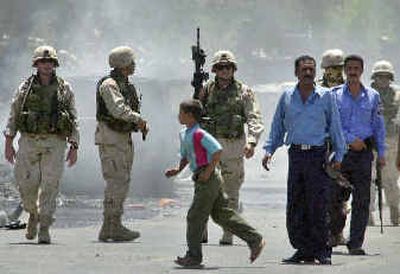British civilians killed in bombing

BAGHDAD, Iraq – A roadside bomb killed two British civilians traveling in an armored car near coalition headquarters on Monday – one of a series of blasts that rocked the center of the Iraqi capital.
After the bombing, insurgents fired mortar rounds around Baghdad. One projectile landed in the Green Zone, which houses coalition headquarters, the U.S. command said, but there were no reports of casualties or damage.
Another mortar shell damaged the roof of a primary school; classes had ended for the day, and no injuries were reported. Another mortar round exploded in the Karrada district.
The blast that killed the two Britons occurred about 50 yards from “Assassins Gate,” one of the main entrances to the Green Zone and scene of a truck bombing in January that killed more than 30 people, mostly Iraqis.
U.S. soldiers tried to pull the men from the flaming vehicle and quickly sealed off the area. Brig. Gen. Mark Kimmitt, chief U.S. military spokesman, said two people were killed and two others were wounded; he refused to identify them further.
In London, the Foreign Office said two British citizens were killed and another was injured in the blast. At least one of the dead worked for Control Risks Group, a private contractor that provides security and risk assessments. Twelve British civilians have died in Iraq since last July.
Police officer Mohammed Naem, who saw the blast, said the vehicle was a bulletproof Toyota Land Cruiser and had been headed to the convention center in the Green Zone.
“I saw the roof of the car flying,” taxi driver Mohammed Saleh said.
Ali Salman, who works at a nearby restaurant, said the car was in a convoy, and that two men in an accompanying car started “haphazardly shooting” after the explosion.
“The passengers got out and started shooting and then raced off,” he said.
Just a week ago, the president of the Iraqi Governing Council, Izzadine Saleem, died along with at least six other people in a suicide bombing near coalition headquarters.
The violence has persisted as U.N. envoy Lakhdar Brahimi seeks to put together a government to take power from the U.S.-run occupation authority on June 30.
On Monday, the United States and Britain sought international backing for their plans for Iraq after the handover, proposing a new U.N. resolution that would endorse the power transfer and authorize a U.S.-led multinational force to keep the peace.
The draft does not specify how much say Iraq’s new government will have over foreign and Iraqi forces, nor does it set a timetable for American forces to depart. Although the occupation formally ends June 30, more than 135,000 U.S. troops and 19,000 soldiers from Britain and other nations will remain.
Elsewhere, clashes between U.S. forces and fighters loyal to radical cleric Muqtada al-Sadr in the holy city of Najaf killed at least one person and injured 20, a hospital official said. One person was killed and two were injured Monday in skirmishes in nearby Kufa, according to Ihsan Ibrahim of the Furat al-Awsat hospital.
There were no reports of U.S. casualties.
Some of the Najaf fighting took place in the Revolution of 1920 Square and was so intense the steel fence between the square and an adjacent cemetery was destroyed. Three mortar rounds landed about 300 yards from the Imam Ali shrine, one of Shiite Islam’s holiest sites. Witnesses said there were no casualties.
U.S. planes dropped pamphlets over Najaf urging people to provide information on al-Sadr’s militia. The leaflets said al-Sadr and his “criminal acts” were inhibiting the development of Iraqi society.
On Sunday, U.S. and Iraqi security forces raided a Kufa mosque where they said insurgents stored weapons. The military said at least 32 al-Sadr fighters were killed.
Al-Sadr launched an uprising last month after coalition officials closed his newspaper, arrested a top aide and announced an arrest warrant charging him in the 2003 killing of a rival cleric.
According to figures compiled by The Associated Press, about 315 Shiite insurgents and 21 coalition troops have been killed in al-Sadr’s uprising since early April.